What'sNEW May - Jul 2020
 Aerobic microbial life persists in oxic marine sediment as old as 101.5 million years by Yuki Morono, Steven D'Hondt, Fumio Inagaki et al., doi:10.1038/s41467-020-17330-1, Nature Communications, 28 Jul 2020. Aerobic microbial life persists in oxic marine sediment as old as 101.5 million years by Yuki Morono, Steven D'Hondt, Fumio Inagaki et al., doi:10.1038/s41467-020-17330-1, Nature Communications, 28 Jul 2020.
 Scientists pull living microbes, possibly 100 million years old, from beneath the sea by Elizabeth Pennisi, Science, 28 Jul 2020. Scientists pull living microbes, possibly 100 million years old, from beneath the sea by Elizabeth Pennisi, Science, 28 Jul 2020.
 Thanks, Gordon Cooper, Ted Steele and Rob Cooper. Thanks, Gordon Cooper, Ted Steele and Rob Cooper.
 Bacteria... cites more evidence of their durability. Bacteria... cites more evidence of their durability.
Images from NASA'S Opportunity, Spirit and Curiosity rovers are spliced and edited to make a high-definition, ten-minute virtual tour of Mars.
 Mars In 4K, ElderFox Documentaries, YouTube, 17 Jul 2020. Mars In 4K, ElderFox Documentaries, YouTube, 17 Jul 2020.
 Thanks, Rob Cooper. Thanks, Rob Cooper.
The crew on another fishing boat show up with coronavirus.
 Alaska fishing boat has 85 crew members infected with virus, AP News, 20 Jul 2020. Alaska fishing boat has 85 crew members infected with virus, AP News, 20 Jul 2020.
Viral epidemics and panspermia are related, as Chandra Wickramasinghe explains in a new short video. It includes some striking facts about the Spanish Flu of 1918-19.
 Viruses and Evolution from Space: 16-minute YouTube video, posted 18 Jul 2020. Viruses and Evolution from Space: 16-minute YouTube video, posted 18 Jul 2020.
Microbial life is known to survive in all sorts of extreme environments by going into a dormant state. Could they have survived long trips around our galaxy to seed life on Earth? the European Space Agency asks. The answer is Yes, according to ESA astrobiologist Nicol Caplin.
 ...Extreme life: 5-minute ESA video, posted 17 Jul 2020. ...Extreme life: 5-minute ESA video, posted 17 Jul 2020.
 Thanks, Ted Steele. Thanks, Ted Steele.
 Bacteria: The Space Colonists has discussion and updated news. Bacteria: The Space Colonists has discussion and updated news.
Fishermen isolated at sea were somehow infected with coronavirus. All 61 had tested negative and undergone 14-day quarantine before departure. The first symptoms came after 35 days at sea. Eventually 57 contracted the virus. This makes sense if the virus travels worldwide on winds in the high atmosphere, and ocean spray delivers a potent dose.
 Mystery as Argentine sailors infected with virus after 35 days at sea, AFP via Yahoo!News, 13 Jul 2020. Mystery as Argentine sailors infected with virus after 35 days at sea, AFP via Yahoo!News, 13 Jul 2020.
 Mid-Ocean Outbreaks of COVID-19 with Tell-Tale Signs of Aerial Incidence by George A. Howard et al., doi:10.37421/Virol Curr Res.2020.4.114, Virol Curr Res, 13 Aug 2020. Mid-Ocean Outbreaks of COVID-19 with Tell-Tale Signs of Aerial Incidence by George A. Howard et al., doi:10.37421/Virol Curr Res.2020.4.114, Virol Curr Res, 13 Aug 2020.
The asteroid Ryugu appears rich in organics. A mission by the Japanese Space Agency, JAXA, has landed on it and returned movies. The pictures show that exposure to space radiation brightens the rocks as it would if they contain organics. The mission has also collected a sample scheduled to return to Earth in December.
 The Albedo of Ryugu: Evidence for a High Organic Abundance, as Inferred from the Hayabusa2 Touchdown Maneuver by Christian Potiszil et al., doi:10.1089/ast.2019.2198, Astrobiology, 15 Jul 2020. The Albedo of Ryugu: Evidence for a High Organic Abundance, as Inferred from the Hayabusa2 Touchdown Maneuver by Christian Potiszil et al., doi:10.1089/ast.2019.2198, Astrobiology, 15 Jul 2020.
 What'sNEW under Comet Rendezvous has related links. What'sNEW under Comet Rendezvous has related links.
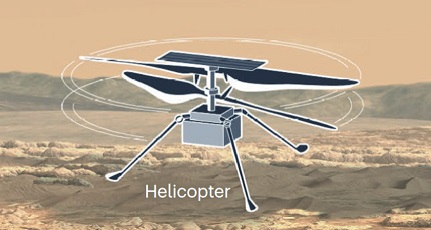 The United States, China and the United Arab Emirates will soon launch missions to a notoriously dangerous destination for spacecraft.
The United States, China and the United Arab Emirates will soon launch missions to a notoriously dangerous destination for spacecraft.
 Countdown to Mars: three daring missions take aim at the red planet by
Alexandra Witze, Smriti Mallapaty and Elizabeth Gibney, Nature, 07 Jul 2020. Countdown to Mars: three daring missions take aim at the red planet by
Alexandra Witze, Smriti Mallapaty and Elizabeth Gibney, Nature, 07 Jul 2020.
 Life on Mars! has more. Life on Mars! has more.
 28 Oct 2015: A fossil on Mars? 28 Oct 2015: A fossil on Mars?
We believe that [Europa's] ocean could be quite habitable for life — Mohit Melwani Daswani, JPL.
 A Suggestive Model for Europa's Ocean by Paul Gilster, Centauri Dreams, 25 Jun 2020. A Suggestive Model for Europa's Ocean by Paul Gilster, Centauri Dreams, 25 Jun 2020.
...early oceans may have been common in the interiors of large Kuiper belt objects.
 Evidence for a hot start and early ocean formation on Pluto by Carver J. Bierson, Francis Nimmo and S. Alan Stern, Nature Geoscience, 22 Jun 2020. Evidence for a hot start and early ocean formation on Pluto by Carver J. Bierson, Francis Nimmo and S. Alan Stern, Nature Geoscience, 22 Jun 2020.
 Thanks, Ronnie McGhee. Thanks, Ronnie McGhee.
 Are Planets with Oceans Common in the Galaxy? It's Likely, NASA Scientists Find by Lonnie Shekhtman, NASA's Goddard Space Flight Center (+Newswise), 18 Jun 2020. Are Planets with Oceans Common in the Galaxy? It's Likely, NASA Scientists Find by Lonnie Shekhtman, NASA's Goddard Space Flight Center (+Newswise), 18 Jun 2020.
 Life on Europa, Other Moons, Other Planets? has links about nearby ocean worlds. Life on Europa, Other Moons, Other Planets? has links about nearby ocean worlds.
Angiosperm genes look ∼70 million years too old. This is the latest example of a persistent, one-way mismatch: by molecular clock dating, genes always look too old. The conflict is difficult to reconcile with standard darwinian theory, in which genes need to be expressed in order to acquire programming. But in cosmic ancestry the genes always come first.
"...Fossil evidence [hexagons] suggests that flowering plants arose near the beginning of the Cretaceous, but molecular analyses [circles] date the origin much earlier, in the Triassic."
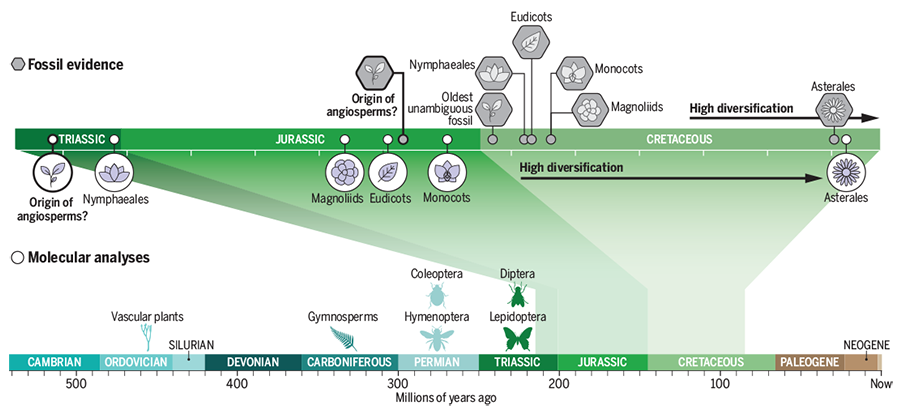
 The origins of flowering plants and pollinators by Casper J. van der Kooi and Jeff Ollerton, doi:10.1126/science.aay3662, Science, 19 Jun 2020. The origins of flowering plants and pollinators by Casper J. van der Kooi and Jeff Ollerton, doi:10.1126/science.aay3662, Science, 19 Jun 2020. |
 Metazoan Genes Older Than Metazoa? and Metazoan Genes Older Than Metazoa? and
 Genes Older Than Earth? have related evidence. Genes Older Than Earth? have related evidence.
Darwinism versus Creationism is the subject of the 2019 Survey of American Science Teachers. The National Science Foundation, the survey sponsor, exhibits no awareness of any alternative to these two choices. Their report concludes ...it seems especially important to identify strategies that are helpful in not only discouraging the advocacy of creationism but also increasing the numbers of teachers who consistently convey a scientifically accurate and pedagogically appropriate presentation of evolution in the high school biology classroom.
 Teaching evolution in U.S. public schools: a continuing challenge by Eric Plutzer, Glenn Branch and Ann Reid, doi:10.1186/s12052-020-00126-8, Evo Edu Outreach, 09 Jun 2020. Teaching evolution in U.S. public schools: a continuing challenge by Eric Plutzer, Glenn Branch and Ann Reid, doi:10.1186/s12052-020-00126-8, Evo Edu Outreach, 09 Jun 2020.
 Thanks, Science. Thanks, Science.
 Evolution versus Creationism has related discussion and links. Evolution versus Creationism has related discussion and links.
 Compare Darwinism, Creationism/ID, Cosmic Ancestry. Compare Darwinism, Creationism/ID, Cosmic Ancestry.
| 16 Jun 2020 |
What'sNEW about HGT  | | |
...a novel catalytic capability was added to the regulatory repertoire of metazoan cells by HGT. The newly acquired regulatory function is likely to have enhanced biochemical diversity in animals, according to a collaboration of British and Swiss geneticists.
 Protein citrullination was introduced into animals by horizontal gene transfer from cyanobacteria by Thomas F. M. Cummings et al., doi:10.1101/2020.06.13.15003, bioRxiv preprint posted 15 Jun 2020. Protein citrullination was introduced into animals by horizontal gene transfer from cyanobacteria by Thomas F. M. Cummings et al., doi:10.1101/2020.06.13.15003, bioRxiv preprint posted 15 Jun 2020.
 Thanks, Google Alerts. Thanks, Google Alerts.
 Viruses and Other Gene Transfer Mechanisms has links to many other examples. Viruses and Other Gene Transfer Mechanisms has links to many other examples.
A respiratory physician reports on an outbreak of corona virus on a cruise ship. He was among 217 passengers and crew who set out with no detected or suspected cases. The first few cases appeared a week later. Eventually, ~60% tested positive. Of those, ~80% showed no symptoms, one died and two remain hospitalized. The isolation and complete testing make it a rare case-study.
For 28 days, following its departure from Ushuaia, Argentina, on March 15, the ship had no outside human contact, apart from Uruguayan medical staff who boarded the ship to test and assess all passengers and crew, while equipped with full PPE.
 ...COVID-positive passengers on Antarctic cruise ship... by Sarah Maguire, Macquarie University, 04 Jun 2020. ...COVID-positive passengers on Antarctic cruise ship... by Sarah Maguire, Macquarie University, 04 Jun 2020.
 COVID-19: in the footsteps of Ernest Shackleton by Alvin J Ing, Christine Cocks and Jeffery Peter Green, doi:10.1136/thoraxjnl-2020-215091 (Open Access), Thorax, May 2020. COVID-19: in the footsteps of Ernest Shackleton by Alvin J Ing, Christine Cocks and Jeffery Peter Green, doi:10.1136/thoraxjnl-2020-215091 (Open Access), Thorax, May 2020.
 Thanks, Chandra Wickramasinghe. Thanks, Chandra Wickramasinghe.
All of our  Book Reviews have a new chronological index with links. Book Reviews have a new chronological index with links.
To protect human health and earthly life, new organizations are aspiring to catalog all the dangerous genes in the world. The undertaking is mindboggling. Even if the ultimate goal is unreachable, the effort would surely be fruitful.
...there is an urgent need to establish a global, genomic-based biosurveillance platform, a development which would be of immense value to biosecurity, biodefense, and the economy. If implemented, this "pandemic interception system" would hugely advance our understanding of the natural world.

 Opinion: Intercepting pandemics through genomics by W. John Kress, Jonna A. K. Mazet, and Paul D. N. Hebert, doi:10.1073/pnas.2009508117 (Open Access), PNAS, 03 Jun 2020. Opinion: Intercepting pandemics through genomics by W. John Kress, Jonna A. K. Mazet, and Paul D. N. Hebert, doi:10.1073/pnas.2009508117 (Open Access), PNAS, 03 Jun 2020. |
| 03 Jun 2020 | What'sNEW about HGT  | | |
 Evidence suggests part of key gene needed for insect reproduction came from bacterial genomes
Evidence suggests part of key gene needed for insect reproduction came from bacterial genomes
 Horizontal helper [human interest story] by Peter Reuell, The Harvard Gazette, 02 Jun 2020. Horizontal helper [human interest story] by Peter Reuell, The Harvard Gazette, 02 Jun 2020.
 Viruses and Other Gene Transfer Mechanisms has background and many other examples. Viruses and Other Gene Transfer Mechanisms has background and many other examples.
... there is a realistic possibility that Mars hosts indigenous microbial life, according to a number of experts in astrobiology and related topics. They met last November in New Mexico to discuss, among other things, "measurement techniques that could be used to detect evidence of extant life (if present)." We wonder if the Chiral Labelled Release experiment proposed by Gil Levin was considered. The original LR experiment on the Viking missions got positive results for life on Mars in 1977. Subsequently the results were attributed to unanticipated chemical reactions. The chiral version could easily tell the difference.
 A Chiral Labeled Release Instrument for In Situ Detection of Extant Life by A.D. Anbar and G.V. Levin, 2012. A Chiral Labeled Release Instrument for In Situ Detection of Extant Life by A.D. Anbar and G.V. Levin, 2012.
 Mars Extant Life: What's Next? Conference Report, Astrobiology, online 28 May 2020. Mars Extant Life: What's Next? Conference Report, Astrobiology, online 28 May 2020.
 Life on Mars!: mentions the Viking LR experiment with updates. Life on Mars!: mentions the Viking LR experiment with updates.
A brief history of astrobiology from the UK omits the most important UK astrobiologists of all, Fred Hoyle (1915-2001) and Chandra Wickramasinghe (b. 1939). Their analysis of interstellar dust produced a series of discoveries that pointed to life in space, and astrobiology was launched. What was Charles Cockell thinking?! Correcting links follow, below.
 Astronomy + biology by C.S. Cockell, Astron. & Geophys., Jun 2020. Astronomy + biology by C.S. Cockell, Astron. & Geophys., Jun 2020.
 Astronomy + Biology revisited (.docx) by Wickramasinghe et al., invited response, Astron. & Geophys., 31 May 2020. Astronomy + Biology revisited (.docx) by Wickramasinghe et al., invited response, Astron. & Geophys., 31 May 2020.
 The Beginnings of Astrobiology | local PDF, Chandra Wickramasinghe, Int. J. Astrobiol., 30 Sep 2002. The Beginnings of Astrobiology | local PDF, Chandra Wickramasinghe, Int. J. Astrobiol., 30 Sep 2002.
 The case for life as a cosmic phenomenon by F. Hoyle and N.C. Wickramasinghe, Nature, 07 Aug 1986. The case for life as a cosmic phenomenon by F. Hoyle and N.C. Wickramasinghe, Nature, 07 Aug 1986.
 Hoyle and Wickramasinghe's Analysis of Interstellar Dust: our brief history with references, links and updates. Hoyle and Wickramasinghe's Analysis of Interstellar Dust: our brief history with references, links and updates.
 Fred Hoyle Interviewed... and Fred Hoyle Interviewed... and
 Chandra Wickramasinghe have more. Chandra Wickramasinghe have more.
An asteroid with a tail like a comet has been located by a monitoring system with telescopes around the globe. This asteroid orbits along the same path as Jupiter and is thought to have been there, inactive, for billions of years. (But see update below.) Now its contents are venting or erupting out, leaving a visible tail.
 UH ATLAS telescope discovers first-of-its-kind asteroid, Institute for Astronomy, University of Hawaii, 20 May 2020. UH ATLAS telescope discovers first-of-its-kind asteroid, Institute for Astronomy, University of Hawaii, 20 May 2020.
 Freaky 'Active' Object in Jupiter's Orbit Is First of Its Kind Seen by Astronomers by George Dvorsky, Gizmodo, 21 May 2020. Freaky 'Active' Object in Jupiter's Orbit Is First of Its Kind Seen by Astronomers by George Dvorsky, Gizmodo, 21 May 2020.
 Thanks, Rob Cooper. Thanks, Rob Cooper.
 Comets: The Delivery System has background and updates. Comets: The Delivery System has background and updates.
 Bacteria... can remain viable for billions of years. Leslie Orgel agrees. Bacteria... can remain viable for billions of years. Leslie Orgel agrees.
UPDATE:  Jupiter Has Trapped a Comet in a Bizarre Orbit by Jeff Hecht, Sky & Telescope, 28 May 2020. Jupiter Has Trapped a Comet in a Bizarre Orbit by Jeff Hecht, Sky & Telescope, 28 May 2020.
 Astronomers recategorize asteroid-like comet..., University of Hawai'i News, 26 May 2020. Astronomers recategorize asteroid-like comet..., University of Hawai'i News, 26 May 2020.
NEW:  Initial Characterization of Active Transitioning Centaur, P/2019 LD2... by Bryce T. Bolin et al., doi:10.3847/1538-3881/abd94b, The Astronomical Journal, 11 Feb 2021. Initial Characterization of Active Transitioning Centaur, P/2019 LD2... by Bryce T. Bolin et al., doi:10.3847/1538-3881/abd94b, The Astronomical Journal, 11 Feb 2021.
This evolutionary history implies that the Jezero-lake floor would have... hosted an active environment of significant astrobiological importance.
 Estimated Minimum Life Span of the Jezero Fluvial Delta (Mars) by Francesco Salese et al., Astrobiology, 20 May 2020. Estimated Minimum Life Span of the Jezero Fluvial Delta (Mars) by Francesco Salese et al., Astrobiology, 20 May 2020.
 Life on Mars! has lots more. Life on Mars! has lots more.
 Our hemoglobin evolved by duplication, divergence and recombinations of ancient gene sequences, according to an international team coordinated at the University of Chicago. The project aimed to reconstruct the evolutionary history of vertebrate hemoglobin by reasoning backward from today's genetic sequences. (Its method is similar to the analysis of snake venom reported here yesterday.)
Our hemoglobin evolved by duplication, divergence and recombinations of ancient gene sequences, according to an international team coordinated at the University of Chicago. The project aimed to reconstruct the evolutionary history of vertebrate hemoglobin by reasoning backward from today's genetic sequences. (Its method is similar to the analysis of snake venom reported here yesterday.)
Here we use ancestral protein reconstruction and biophysical assays to elucidate the origins of vertebrate haemoglobin.... We show that modern haemoglobin evolved from an ancient monomer and characterize the historical 'missing link' through which the modern tetramer evolved—a noncooperative homodimer with high oxygen affinity that existed before the gene duplication that generated distinct... subunits.
This project is also deep and thorough, and the results are impressive. But both teams traced the "origins" of the studied genetic programs to pre-existing ancient genes. Thus, the kernels of the programs apparently were available already. If so, the tinkering to unlock their potential, while not inventive, is still remarkable.
 Origin of complexity in haemoglobin evolution by Arvind S. Pillai et al., doi:10.1038/s41586-020-2292-y, Nature (+alternate); and commentary:
Extinct proteins resurrected to reconstruct the evolution of vertebrate haemoglobin by Michael Berenbrink, Nature, 20 May 2020. Origin of complexity in haemoglobin evolution by Arvind S. Pillai et al., doi:10.1038/s41586-020-2292-y, Nature (+alternate); and commentary:
Extinct proteins resurrected to reconstruct the evolution of vertebrate haemoglobin by Michael Berenbrink, Nature, 20 May 2020.
 Duplication... has updates. Duplication... has updates.
 Testing Darwinism... has relevant comments. Testing Darwinism... has relevant comments.
 Genes Older Than Earth? is consistent with the possibility that evolution is actually development. Genes Older Than Earth? is consistent with the possibility that evolution is actually development.
 Robust Software Management... acknowledges that unlocking the hidden potential of genes is remarkable. Robust Software Management... acknowledges that unlocking the hidden potential of genes is remarkable.
Where do new genes come from? A favored answer from standard darwinian theory is gene duplication, as Susumo Ohno suggested fifty years ago. After duplication, the new alleles can diverge. If the parent gene contained two or more functions, each daughter allele may specialize in one of them. This process, "subfunctionalization," is well observed.
Another outcome, called "neofunctionalization," is supposed to produce functions that were not contained in the original gene. Rattlesnake venoms provide a vivid example, according to new research using sequence data to reconstruct the evolution of those genes. We are awed by the scope and depth of the study. But we doubt that loss of sequence can invent anything. We see subfunctionalization here, too.
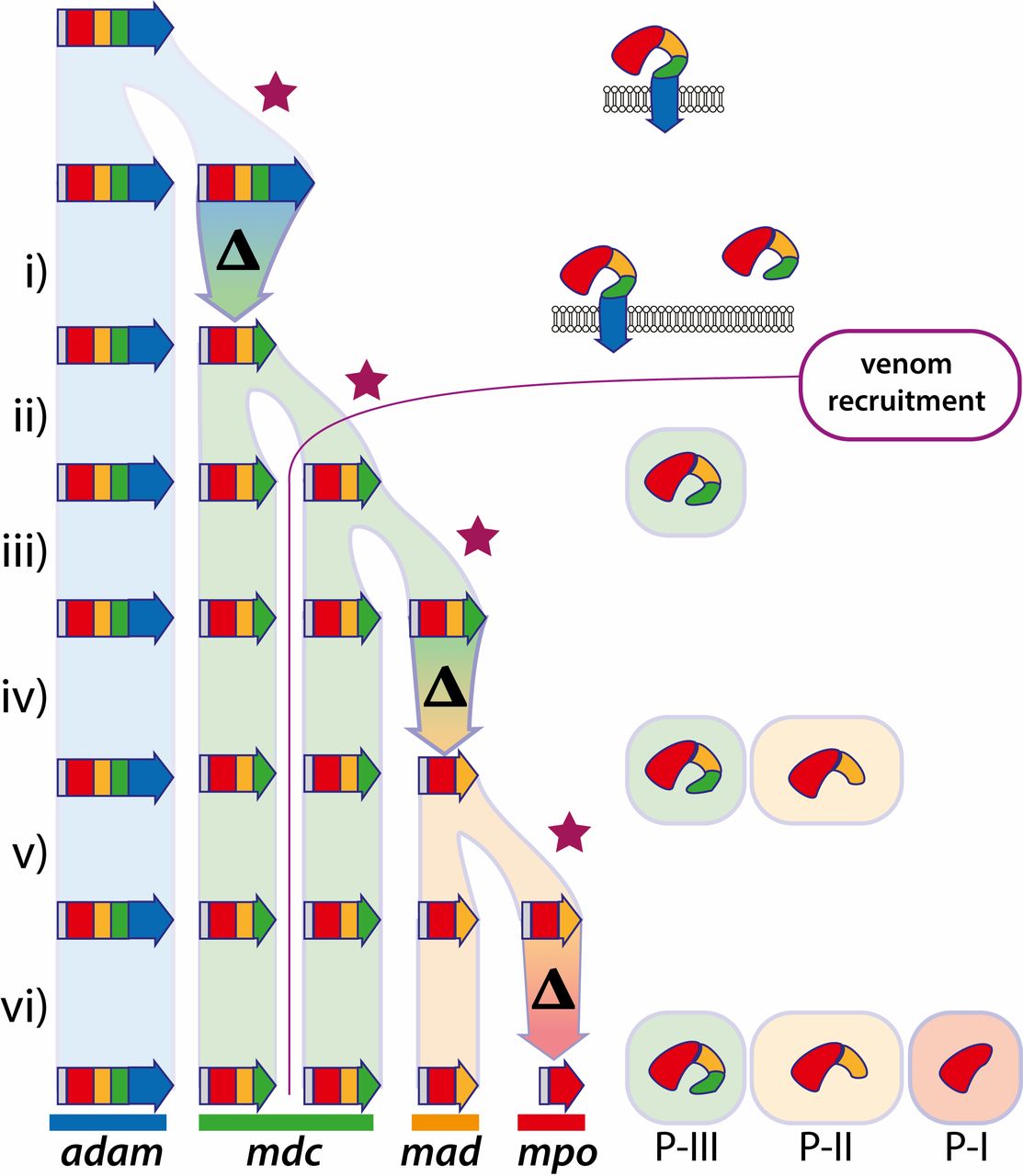
| "Here, we have traced the origin and diversification of one prominent family, the snake venom metalloproteinases (SVMPs) that play key roles in subduing prey in many vipers. ...We have shown that the that this 30-gene complex has been massively expanded in the rattlesnake lineage from a single, deeply conserved ancestral disintegrin and metalloproteinase (adam28) gene. In addition, we have identified a series of stepwise intragenic deletions that gave rise to three major classes of secreted SVMP toxins by the successive removal of [three domains]. ...These findings allow us to reconstruct the genetic path of snake venom SVMP innovation ...and to consider which evolutionary forces may best explain their genesis. ... there is no doubt that the massive expansion and diversification of SVMP genes that encode major components of prey-killing venom has involved episodes of positive selection. ...the SVMPs present a case of neofunctionalization [?] via domain loss.
|
 The origin and diversification of a novel protein family in venomous snakes by Matt W. Giorgianni, Noah L. Dowell, Sam Griffin, Victoria A. Kassner, Jane E. Selegue, and Sean B. Carroll, doi:10.1073/pnas.1920011117, 10 pages, open access, PNAS, 19 May 2020. The origin and diversification of a novel protein family in venomous snakes by Matt W. Giorgianni, Noah L. Dowell, Sam Griffin, Victoria A. Kassner, Jane E. Selegue, and Sean B. Carroll, doi:10.1073/pnas.1920011117, 10 pages, open access, PNAS, 19 May 2020.
 Duplication... has become our main webpage for evidence pertaining to sub- or neofunctionalization. Duplication... has become our main webpage for evidence pertaining to sub- or neofunctionalization.
 Testing Darwinism... includes comments about historical reconstructions like this one. Testing Darwinism... includes comments about historical reconstructions like this one.
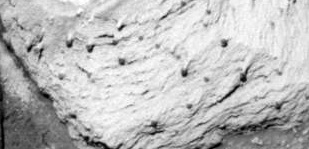 Evidence for Life on Mars deserves another look according to four astrobiologists studying photos taken by NASA's Opportunity rover. The abundant "blueberries" are not likely to be mineral accretions, they first maintain. Many of the blueberries seem to grow like mushrooms on stalks, leaning the same way as if aiming for sunlight. (Cropping, right, from sol 88, Panoramic Camera, 2004.)
Evidence for Life on Mars deserves another look according to four astrobiologists studying photos taken by NASA's Opportunity rover. The abundant "blueberries" are not likely to be mineral accretions, they first maintain. Many of the blueberries seem to grow like mushrooms on stalks, leaning the same way as if aiming for sunlight. (Cropping, right, from sol 88, Panoramic Camera, 2004.)
Blueberries grew noticeably and new ones appeared in only 3 days in 2007 (sols 1145-1148, Microscopic Imager photos below).
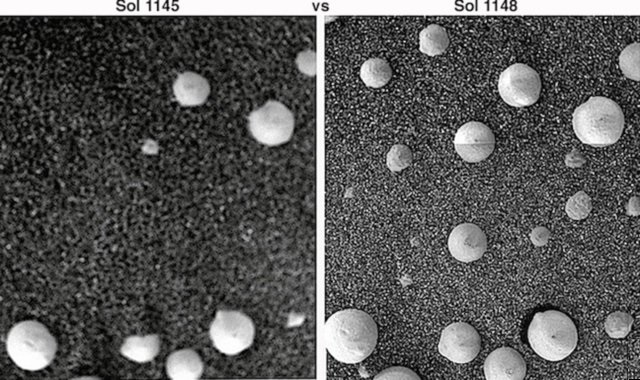
 Opportunity: All 228,771 Raw Images, Mars.NASA.gov. Opportunity: All 228,771 Raw Images, Mars.NASA.gov.
 sol 1145 | sol 1148 (rotate 90° clockwise to match left.) sol 1145 | sol 1148 (rotate 90° clockwise to match left.)
 Life on Mars: Colonies of Photosynthesizing Mushrooms in Eagle Crater?... by Rhawn Gabriel Joseph, R. A. Armstrong, Giora J. Kidron and Rudolph E. Schild, doi:10.37720/jassr.04172020, J. Astrobiol. & Space Sci. Res., Apr 2020. Life on Mars: Colonies of Photosynthesizing Mushrooms in Eagle Crater?... by Rhawn Gabriel Joseph, R. A. Armstrong, Giora J. Kidron and Rudolph E. Schild, doi:10.37720/jassr.04172020, J. Astrobiol. & Space Sci. Res., Apr 2020.
 Thanks, Stan Franklin. Thanks, Stan Franklin.
 Life on Mars! has more. Life on Mars! has more.
 07 May 2021: more from Joseph et al. 07 May 2021: more from Joseph et al.
FWIW:
 Opportunity sol 029 | local copy: Some blueberries have seams like peaches. Opportunity sol 029 | local copy: Some blueberries have seams like peaches.
 Opportunity sol 034 | local copy: Blueberries lack internal structure expected in mineral concretions. Opportunity sol 034 | local copy: Blueberries lack internal structure expected in mineral concretions.
| 12 May 2020 | What'sNEW about HGT  | | |
We show that somatic RNA can be transported to the germline and passed on to embryos....
We hypothesized that RNA may be transported from a somatic tissue ...of an adult male mouse to the germline, and subsequently to embryos. To investigate this, we injected one hemisphere of the male mouse striatum with an AAV1/9 virus expressing human pre-MIR941 (MIR941). After 2, 8 and 16 weeks following injection, we ...[detected] the presence of virus and human MIR941 in brain, peripheral tissues and embryos, from injected male mice mated with uninjected females. ...[A] small percentage (~ 1-8%) of MIR941 is transported to the germline and to embryos in about a third of the cases.

 Direct evidence for transport of RNA from the mouse brain to the germline and offspring by Elizabeth A. O'Brien, Kathleen S. Ensbey, Bryan W. Day, Paul A. Baldock and Guy Barry, doi:10.1186/s12915-020-00780-w, BMC Biology, 30 Apr 2020. Direct evidence for transport of RNA from the mouse brain to the germline and offspring by Elizabeth A. O'Brien, Kathleen S. Ensbey, Bryan W. Day, Paul A. Baldock and Guy Barry, doi:10.1186/s12915-020-00780-w, BMC Biology, 30 Apr 2020.
|
 Viruses and Other Gene Transfer Mechanisms has related discussion and all updates. Viruses and Other Gene Transfer Mechanisms has related discussion and all updates.
 James Powers has comments, 16 May 2020. James Powers has comments, 16 May 2020.
...E. coli (a prokaryote) and a much more complex single-cellular microorganism such as yeast (a eukaryote) can thrive in a pure H2 gas environment....
— Sara Seager et al., 2020
Microbes transported by comets may land on environments that are very unlike Earth. Cometary panspermia is more logical and more likely if microbes are able to survive and multiply in a wide variety of worlds. And indeed they can. New evidence from MIT only widens the proven range. But this versatility has no ready explanation in standard evolutionary theory, if microbes have survival capabilities that were never deployed or needed on Earth.
 Laboratory studies on the viability of life in H2-dominated exoplanet atmospheres by Sara Seager et al., doi:10.1038/s41550-020-1069-4, Nature Astronomy, 04 May 2020. Laboratory studies on the viability of life in H2-dominated exoplanet atmospheres by Sara Seager et al., doi:10.1038/s41550-020-1069-4, Nature Astronomy, 04 May 2020.
 Planets with hydrogen-rich atmospheres could harbor life by Lisa Grossman, Science News, 04 May 2020. Planets with hydrogen-rich atmospheres could harbor life by Lisa Grossman, Science News, 04 May 2020.
 Thanks, Stan Franklin. Thanks, Stan Franklin.
 Bacteria: The Space Colonists has lots about their hardiness. Bacteria: The Space Colonists has lots about their hardiness.
![]()
|

 Evidence suggests part of key gene needed for insect reproduction came from bacterial genomes
Evidence suggests part of key gene needed for insect reproduction came from bacterial genomes
 Our hemoglobin evolved by duplication, divergence and recombinations of ancient gene sequences, according to an international team coordinated at the University of Chicago. The project aimed to reconstruct the evolutionary history of vertebrate hemoglobin by reasoning backward from today's genetic sequences. (Its method is similar to the analysis of snake venom reported here yesterday.)
Our hemoglobin evolved by duplication, divergence and recombinations of ancient gene sequences, according to an international team coordinated at the University of Chicago. The project aimed to reconstruct the evolutionary history of vertebrate hemoglobin by reasoning backward from today's genetic sequences. (Its method is similar to the analysis of snake venom reported here yesterday.)

 Evidence for Life on Mars deserves another look according to four astrobiologists studying photos taken by NASA's Opportunity rover. The abundant "blueberries" are not likely to be mineral accretions, they first maintain. Many of the blueberries seem to grow like mushrooms on stalks, leaning the same way as if aiming for sunlight. (Cropping, right, from sol 88, Panoramic Camera, 2004.)
Evidence for Life on Mars deserves another look according to four astrobiologists studying photos taken by NASA's Opportunity rover. The abundant "blueberries" are not likely to be mineral accretions, they first maintain. Many of the blueberries seem to grow like mushrooms on stalks, leaning the same way as if aiming for sunlight. (Cropping, right, from sol 88, Panoramic Camera, 2004.)

